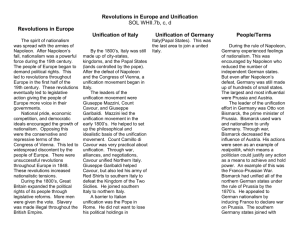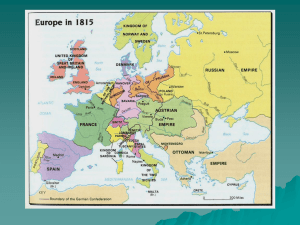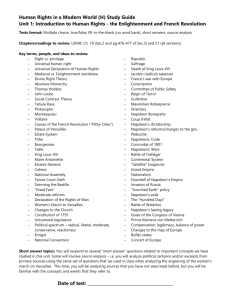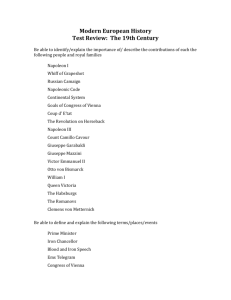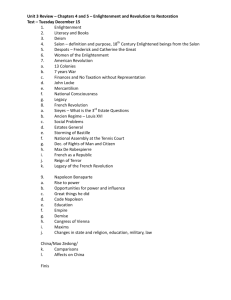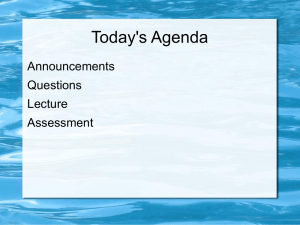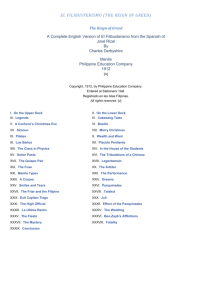TestNationalism
advertisement
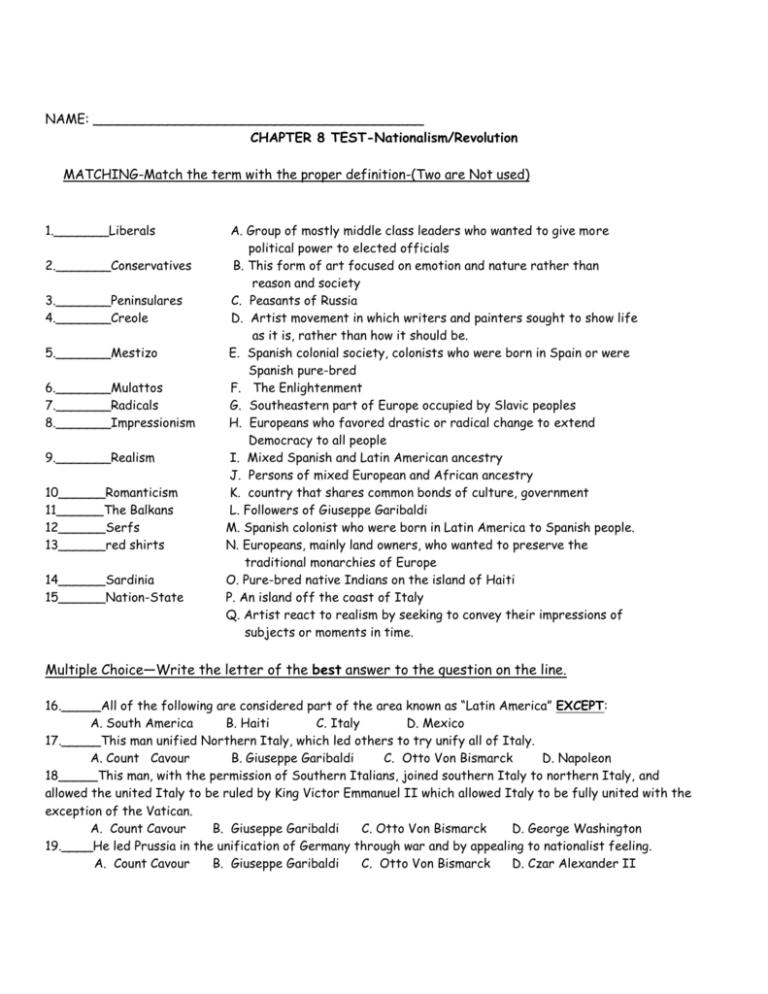
NAME: ________________________________________ CHAPTER 8 TEST-Nationalism/Revolution MATCHING-Match the term with the proper definition-(Two are Not used) 1._______Liberals 2._______Conservatives 3._______Peninsulares 4._______Creole 5._______Mestizo 6._______Mulattos 7._______Radicals 8._______Impressionism 9._______Realism 10______Romanticism 11______The Balkans 12______Serfs 13______red shirts 14______Sardinia 15______Nation-State A. Group of mostly middle class leaders who wanted to give more political power to elected officials B. This form of art focused on emotion and nature rather than reason and society C. Peasants of Russia D. Artist movement in which writers and painters sought to show life as it is, rather than how it should be. E. Spanish colonial society, colonists who were born in Spain or were Spanish pure-bred F. The Enlightenment G. Southeastern part of Europe occupied by Slavic peoples H. Europeans who favored drastic or radical change to extend Democracy to all people I. Mixed Spanish and Latin American ancestry J. Persons of mixed European and African ancestry K. country that shares common bonds of culture, government L. Followers of Giuseppe Garibaldi M. Spanish colonist who were born in Latin America to Spanish people. N. Europeans, mainly land owners, who wanted to preserve the traditional monarchies of Europe O. Pure-bred native Indians on the island of Haiti P. An island off the coast of Italy Q. Artist react to realism by seeking to convey their impressions of subjects or moments in time. Multiple Choice—Write the letter of the best answer to the question on the line. 16._____All of the following are considered part of the area known as “Latin America” EXCEPT: A. South America B. Haiti C. Italy D. Mexico 17._____This man unified Northern Italy, which led others to try unify all of Italy. A. Count Cavour B. Giuseppe Garibaldi C. Otto Von Bismarck D. Napoleon 18_____This man, with the permission of Southern Italians, joined southern Italy to northern Italy, and allowed the united Italy to be ruled by King Victor Emmanuel II which allowed Italy to be fully united with the exception of the Vatican. A. Count Cavour B. Giuseppe Garibaldi C. Otto Von Bismarck D. George Washington 19.____He led Prussia in the unification of Germany through war and by appealing to nationalist feeling. A. Count Cavour B. Giuseppe Garibaldi C. Otto Von Bismarck D. Czar Alexander II 20.___Otto Van Bismarck was known as a “Realpolitik” which means A. the politics of reality, with no room for idealism, strong tough power politics. B. Someone who doesn’t take a firm stand, and takes a weak political position C. A republican C. None of the Above 21.____This war allowed for the creation of a German state. A. Franco-Prussian War B. German-Franco War C. German-Prussian War D. The French Revolution 22.____He was a Creole who led to revolt against the Spanish in Venezuela, Columbia and Peru. A. Padre Hildago B. Toussaint L’Ouventure C. Simon Bolivar D. Fidel Castro 23. ____This man was the original leader of the slave revolt in Haiti. A. Padre Hildago B. Toussaint L’Ouventure C. Jean-Jacques Dessaline D. Napoleon 24.____These two men led mestizos and natives to revolt against the Spanish in Mexico. A. Padre Hildago and Padre Morelos B. Padre Simon Bolivar and Toussaint L’Ouventure C. Padre Van Bismarck and Padre Cavour D. Don Juan and Giuseppe Garibaldi 25.____This was the only "bloodless" revolution in Latin America. A. Portugal B. Mexico C. Brazil D. Haiti 26.____He was the leader of Russia that finally freed serfs permanently and who wanted to make Russia more industrialized. A. Czar Alexander II B. Louis Napoleon C. Peter the Great D. Simon Bolivar 27.____He was the French leader who was originally elected as a president in 1848, but after 4 years of turmoil he became a dictator to fix France’s problems and took the title of “Emperor Napoleon III” A. Napoleon Bonaparte B. Louis Napoleon C. Peter the Great D. Napoleon XIV 28.___Nationalism is A. pride in one’s leader more than in the country B. pride in one’s country based on a common culture, history or world-view C. Non-existent in today’s world D. None of the above 29.___ How did nationalism and democracy influence national revolutions? A. National pride, economic competition, and democratic ideals stimulated or increased the growth of nationalism. B. The terms of the Congress of Vienna led to widespread discontent in Europe. Unsuccessful revolutions of 1848 increased nationalistic tensions. C. The French Revolution and ideas of the Enlightenment both contributed to nationalistic feelings D. All of the above contributed to national revolutions 30.___ As a result of the nationalistic revolutions and unification efforts, the two countries which emerged as the strongest powers in Europe by 1870 were: A. Britain & France B. Germany & Russia C. Britain & Germany D. Britain & USA 31. ___ The European country that eventually gained controlled of the central part of Europe and became Germany was A. France B. Venezuela C. Prussia D. Russia 32.___The author who wrote “The Hunchback of Notre Dame” and “Les Miserable” was: A. Louis Napoleon B. Mary Shelly C. Charles Dickens D. Victor Hugo 33. ___All of the following were painters during the impressionist period, EXCEPT: A. Claude Monet B. Edgar Degas C. Charles Dickens D. Pierre Renoir 34.___ Wilhelm and Jakob Grimm were best known for their: A. Impressionists paintings B. Invention of the photograph C. Fairy Tales D. The work of art entitled: “Dogs Playing Poker” 35.___The French inventor who was responsible for the first practical photographs was: A. Louis Daguerre B. Louis Napoleon C. Ben Franklin D. Claude Monet 36.___ The author known for stories about London's working poor, such as "Oliver Twist" and "A Christmas Story" was:, A. Mary Shelly B. Lord Byron C. Charles Dickens D. Franz Liszt 37.___ All of the following are factors that serve to bond a nation-state together include all EXCEPT: A. Language B. Culture C. Common ethnic ancestry D. Social class 38.___ The great Latin American liberator who led revolutions in Argentina and Chile was: A. Jose de San Martin B. Ferdinand VII C. Alexander II D. Don Juan 39.___ The greatest romantic composer, known for his 9th symphony was: A. von Goethe B. Beethoven C. Percy Shelly D. Emile Zola 40.___ The first Balkan nation to achieve it's independence against the Ottoman Turks was: A. Russia B. Spain C. Greece D. Italy 41.___ The ONLY statement below that is TRUE is: A. Nationalism and the ideas of the Enlightenment were not connected in any way. B. The Ideas of the Enlightenment had little influence on independence movements C. Most of the revolutions of Latin America were accomplished quickly with little violence. D. By the beginning of 1840 most Latin American nations were independent from the European nations that colonized them. 42.___The two European nations which became unified during this period were: A. Germany & Italy B. Greece & Brazil C. Spain & Italy D. Italy & Portugal 43.___ The bloodless revolt in Brazil was accomplished by naming this man, the son of the Portuguese King, as ruler of Brazil: A. Dom Pedro B. Simon Bolivar C. Padre Hildalgo D. Kaiser Wilhelm 44.____ All of the following were empires that during this period of revolution lost territory EXCEPT: A. Austro-Prussian B. Russian C. Ottoman D. Roman 45.____ All of the following nations became nations from the United Provinces of Central America EXCEPT: A. Mexico B. Costa Rica C. El Salvador D. Guatemala Discussion Question Select one of the following questions and answer it as completely as possible: 1. Explain what is meant by nationalism, and how it contributed to Independence movements. 2. Explain how social class played a role in Revolution by selecting and describing one specific revolution. 3. What is meant by the Enlightenment, name one Enlightenment figure and explain how the Enlightenment influenced this period.
